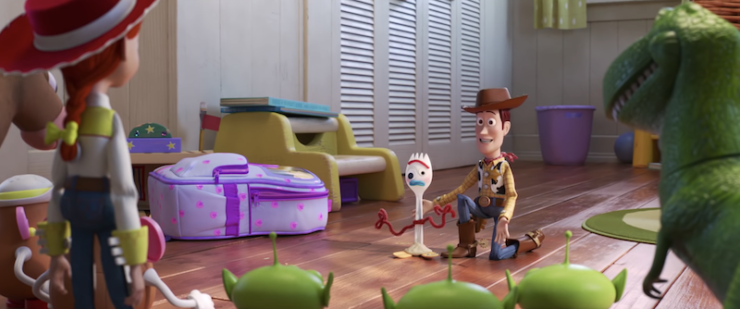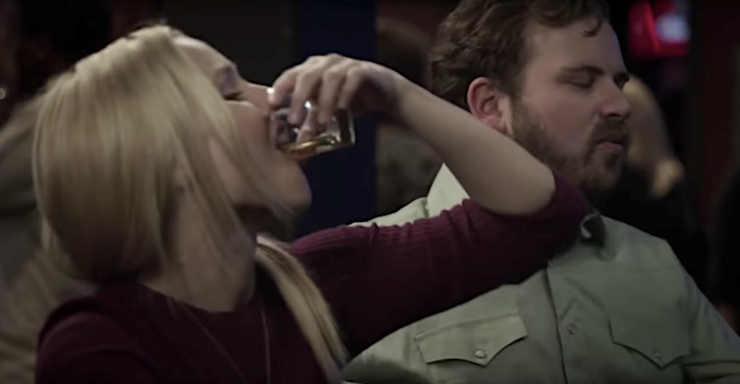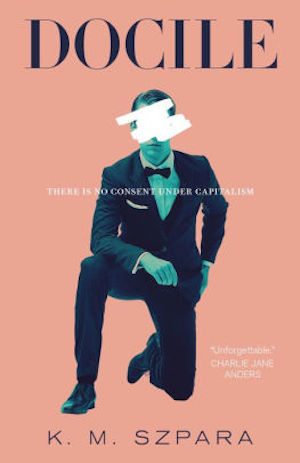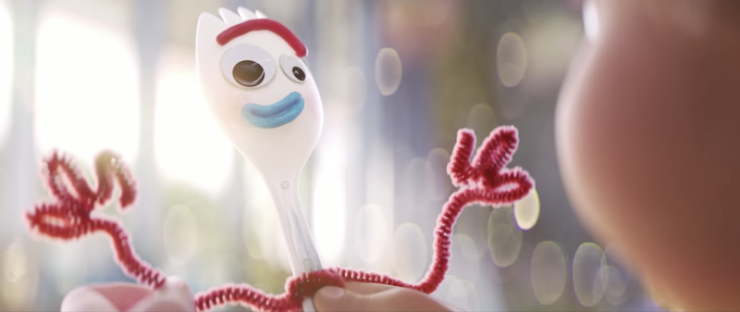I was hoping Forky would end capitalism. After all, all the toys in the Toy Story Universe are bought, packaged, branded, boxed, sold at high prices and given to children for holidays and birthdays. But with the end of Toy Story 3 we had a slightly different paradigm. Andy gave Bonnie his old toys because he’d outgrown them. They were given freely, no strings attached, no dollars exchanged. After two films about birthday presents and online auctions, they were blissfully outside of the market.
Was it naive of me to hope for the next step? To rejoice when Forky was made by Bonnie’s own two little kindergarten paws, not begotten in some sterile toy company boardroom? When Bonnie wrote her name on Forky’s popsicle stick feet, I hoped that we were entering a brave new world, in which the toys would rise up and critique those who would call them mere commodity.
After all, can there be consent under capitalism? Can there be true freedom beneath the baleful eye of Geoffrey Giraffe?
I’ll admit I already have an attachment to Sporks. The idea that someone invented such a perfect object, and gave it such a ridiculous name, appeals to me on a spiritual level. Sporks are also the inspiration for my Favorite Joke in All Of Human History, courtesy of Onion and Community writer Megan Ganz: “Spork Used As Knife.”
So I was disappointed when the film went in a different direction. Instead of Forky Fights the Man, we got Woody Learns to Be an Individual. And I like that movie, sure, but it just wasn’t quite what I wanted?
But there was one thing that kept coming back to me over and over again. One root that kept catching my ankle.
It was the word “trash.”
Forky referred to himself as Trash. Every time he broke free of Woody or Bonnie he made a beeline for the nearest wastebasket. Randy Newman sings “I Won’t Let You Throw Yourself Away” and Forky’s escapes are framed as comical suicide attempts a lá Groundhog Day. But when Woody finally takes the time to ask Forky what he means by trash he learns that the Sentient Spork thinks of trash as warm and cozy.
Safe.

Woody is astonished by this, and explains to Forky that this is exactly how the toys make Bonnie feel.
This is when Forky, alone of the toys, chooses to be Bonnie’s toy. This is a conversion experience of a sort, but Forky doesn’t change. He just transfers the emotions he feels toward garbage cans from receiving comfort, to giving comfort to Bonnie as her toy. He knows he’s still trash, but now he is Bonnie’s trash. Bonnie becomes both his deity and his ward.
From here on Forky doesn’t refer to himself as trash, now he is primarily Bonnie’s toy, with occasional attention paid to being Woody’s friend and Gabby-Gabby’s confidante.
Fine, but why was I fixating on it? Where else had I heard “trash” used so prominently? Well, in a word, everywhere. Social media is awash in people being called trash and garbage, either with affection or condemnation, or occasionally both. Memes of raccoons and possums abound, our true Patronii found at last. And as for other pop culture media: Endgame gave us a Thor who, while still a god, was also a depressive, beer-swilling videogame addict; Barry is probably the best thing on TV right now, full stop, but Barry the character is an amoral killer who’s willing to hit the pause button on his existential questions whenever they get inconvenient; Fleabag is both the title of the show and the highly-descriptive name of the main character; Gritty EXISTS; and, maybe most prominently, there is an Arizona trashbag named Eleanor Shellstrop who will be coming back for the fourth and final season of The Good Place.

When forks appears on The Good Place they’re either spearing shrimp or they’re spoken as stand-ins for the word “fuck.” No one can curse in The Good Place, because reality itself enforces a surface-level morality in which dirty language is made innocuous, like a Sunday School teacher saying “Sugar!” while she’s thinking “Shit!” This isn’t morality, of course—it’s a veneer, or, if you’ll allow me to be blunt: a lie. Rather than embracing their foulness—their fallibility—and making room for it, the people of The Good Place are forced (“forked”) to live in two realities at once, browbeaten into thinking that this reality is an ideal they can never meet.
In a place that promises them “Everything is fine” they are made to feel like, well, trash?
(And of course we, the fandom, embrace that trash and used that play on “Fork” in every iteration we could come up with, gleefully swearing our heads off on Twitter and in the headlines of articles.)
As the show continues this surface cracks, but the characters begin learning ways to embody a deeper kind of ‘goodness’—until, late in season three, they learn that reality itself has become so complex that “goodness” has become impossible. Of course, this is another, deeper lie. Goodness has always been impossible. As long as upper classes profit from poverty, poverty will exist. As long as societies build themselves on slave labor, slavery will exist. In the 21st Century U.S., it’s taken as a given that entire industries will create a symbiotic relationship with toxic masculinity (the Sports Industrial Complex, men’s magazines, etc.) and rape culture (the Beauty Industrial Complex, women’s magazines, etc.)—of course we can’t be good. I can be nice and thoughtful and give money to the North Shore Animal League, but there are still refugees being held in squalor on every continent. I can use a metal straw, but that won’t make much of a dent in climate catastrophe when capitalism depends on sucking the earth dry. (I’m still getting that straw, though.)
Through all the iterations of the Good Place, Eleanor has remained fundamentally “trash.” She loves gossip and white wine and frozen margs and shrimp cocktails and glossy tabloids. She has become a much better person over the three seasons—she’s more thoughtful, more empathetic—but her core tastes remain. As much as she loves Chidi, she still chimes more with Tahani’s juicy celebrity stories than the philosophy of Jonathan Dancy; she and Jason will still high-five over a particularly sweet “That’s what she said.”
Despite all of her moral work, she still self-identifies as a trashbag.

Despite the allure of being collectables or antiques, the toys of the Toy Story Saga choose, again, and again, to be used, played with, broken, torn, to make themselves vulnerable, to risk loss—to be, let’s be real, future trash.
So many of us do.
I was thinking about this as I read a Jia Tolentino piece for The New Yorker, “Love, Death, and Begging for Celebrities to Kill You,” about the sudden uptick in members of fandoms using violent, cartoonishly BDSM language when referring to people they’d like to, uhhh, fork, e.g.: Taylor Swift “could run me over with a tractor and I’d say thank you and ask her if she wants to do it again,” or “I hope Sufjan Stevens walks into my house and smashes a banjo over my head killing me instantly” (I’m not linking to anyone in particular on this one, cause there are a lot of these). Tolentino also makes the point about the quasi-religious roots of this trend, citing John Donne (who wanted God to just wreck him) but this is of course a strong theme in both Judaism and Christianity, the idea of suffering for your faith but also, when possible, enjoying the suffering. That as a sinner or a finite being made of dust you deserve to suffer—that you’re trash. That you should maybe wallow in your own trashiness to meditate on the distance between you, a freaking mess, and the holiness of divinity that you’re supposed to achieve, whether through good works or grace or fasting or repentance or whatever.
Could the language of fandom simply be the latest iteration of this tendency, with people referring to themselves as Tumblr trash or Black Sails trash? With “messy” becoming a high praise term for anything from grassroots political movements to Meghan Markle’s signature hairstyle?
Buy the Book


Docile
I think maybe it started with reality television? Those few hours on MTV or Bravo or E! that avalanched into poring over the escapades of heiresses with the same gusto with which we absorbed the worst moments of crime victims’ lives; drinking every salient detail of the latest Murder Podcast; voting on the pop potential of teenagers.
Or maybe it started with Jonathan Edwards? Not noted reality television ghost whisperer John Edwards, but Jonathan Edwards, the great fire-and-brimstone preacher of the First Great Awakening, circa 1740s, when the buzz of the Puritan colonization was finally wearing off and the children of those holy men and women had to figure out where they stood. When he exhorted his flock to see themselves as sinner in the hands of an angry God, when he said:
The God that holds you over the pit of hell, much as one holds a spider, or some loathsome insect over the fire, abhors you, and is dreadfully provoked: his wrath towards you burns like fire; he looks upon you as worthy of nothing else, but to be cast into the fire; he is of purer eyes than to bear to have you in his sight; you are ten thousand times more abominable in his eyes, than the most hateful venomous serpent is in ours.
What is this but the 18th Century version of calling someone trash? Of warning you that if you aren’t careful, God will cancel you? What is The Good Place but the tale of people and the odd demon trying to become better in the absence of God? What is the Toy Story Saga but the story of gods being replaced—Woody and Buzz transfer their worship from Andy to Bonnie, Forky transfers his feeling of safety and love from trashcan to Bonnie. And after the Durkeheimian power move of Toy Story 3, when the little alien toys seized the means of divine production, taking control of a giant Claw in order to pluck their friends from the Fire, Toy Story 4 gives us another iteration of Toys attaining godhood. Gabby-Gabby, initially coded as a Lotso-esque villain, instead turns out to be a rejected figure, cast aside and insulted. It’s Gabby-Gabby who ascends to a different moral plane in this one. She’s guaranteed a place with Bonnie. She will be welcomed into a family of toys. But on the way to this paradise, she stops, takes a God’s-eye-view of the carnival, and sees a lost child. Throwing away the promise of happiness, coziness, safety, she flings herself into the unknown to help the lost child. But unlike the little alien guys, she can’t stretch the delicate tissue of the Toys’ world—unable to call for help, all she can do is give the little girl the courage to save herself, and hope for the best. It all pays off when a security guard comes to the rescue, and the girl keeps Gabby-Gabby after she’s reunited with her parents; this is a kid’s movie—more or less—but the risk is still real.
Gabby-Gabby goes from being an “antique” with objective value under capitalism, to putting herself at risk of being a lost toy, merely trash, discarded in a dark corner of a carnival. Woody evades the Fire of Toy Story 3 only to risk something even more dangerous: true, pure, existential freedom. And Forky is not just reunited with Bonnie, but ascends himself into the role of teacher when Bonnie creates another trash-toy on her first day in First Grade. Boomers can get misty-eyed over Gabby-Gabby, Xers can look at Woody’s willingness to let go of first Andy and then Bonnie as a call to let their own children grow up. But Millennials? The kids who grew up with Andy? Are they seeing Woody’s choice of a new, intentional life as a call to leave the old systems of society behind to create new forms of meaning? (Maybe? I hope so?)
But the thing that keeps rolling around in my brain, that word trash—Forky is not my trash icon. I already have plenty of those. Forky is a trash icon for all the children who go to this movie. For the new generations who will wear out their blu-Rays. They are being inducted into the Great Millennial Trash Revolution. The trash remains trash, but is animated by love, with all of its terrors.
Leah Schnelbach hopes to one day be as useful as a spork. Come discuss the merits of trash with them on Twitter!










